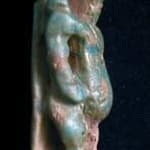New Kingdom Faience Amulet of Ptah-Sokar, 1600 BCE - 600 BCE
Faience
2.25
PF.2989
Further images
The multiplicity of gods in the polytheistic ancient Egyptian pantheon frequently resulted in the merging of the identities of the different gods into one form. This form existed without negating...
The multiplicity of gods in the polytheistic ancient Egyptian pantheon frequently resulted in the merging of the identities of the different gods into one form. This form existed without negating the identities of any of the gods who were merged. The god Ptah-sokar is an example of this synchronization process. Ptah was the creator god of Memphis (who is frequently depicted as a mummiform man wearing a skull cap) and Sokar, the falcon-headed god of the Memphite necropolis. Because both gods had cult centers in Memphis and were patron gods of artisans, their identities were eventually merged into the syncretized form of Ptah-sokar. This green faience figure shows the god as a naked bow-legged dwarf surrounded with a number of symbolic attributes. The god stands with each foot atop the head of a crocodile, and a falcon is perched on each shoulder. A scarab rests on his head, and a winged goddess who wears the horned-disk headdress of Isis or Hathor protects his back.





